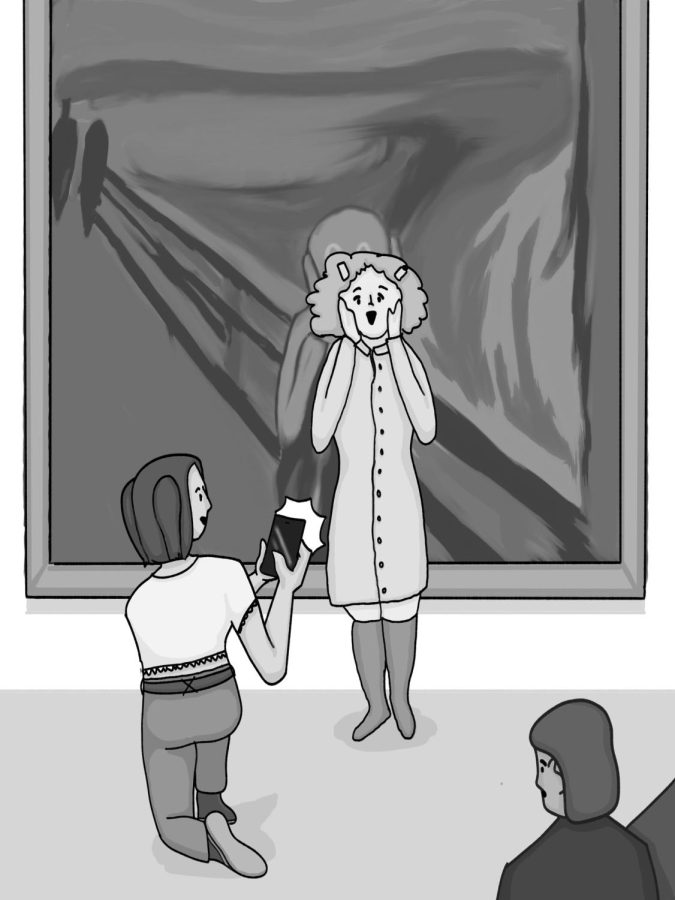A&E: Social media creates a trend of visiting art museums for a different purpose
A stroll through art museums to appreciate fine art has been shaped into an aesthetic experience to share on social media platforms. While some SCHS students question the underlying work of the popular online trend and the effect on the artwork itself, many discovered a newly sparked interest in viewing artistic pieces.
On a day trip to San Francisco with her friends, junior Bijou Lee visited the San Francisco Museum of Modern Art to check off her bucket list.
“I really like more modern and contemporary styles of art, so knowing that the SFMOMA was a well-known museum for this sort of style piqued my interest,” Lee said. “The museum was also located in the heart of San Francisco, which is fairly close by and a fun city to visit, so it also seemed like a sign for me to go.”
After visiting SFMOMA, a modern home to seven gallery floors housing diverse genres of art, Lee shared a memorable piece from her visit.
“I really liked Nam June Paik’s exhibition that was shown back in 2021, particularly his piece titled ‘TV Garden,’” Lee said. “It was really interesting to me because of how he incorporated video technology into his artistic pieces, which is something I personally have never seen before.”
Similar to Lee, sophomore Allysa Celino visited the Japanese American Museum of San Jose on a day trip with a friend to Japantown. With intentions to upload photos on social media, Celino came to discover a newfound admiration for historical artwork.
“It was kind of depressing because the museum focuses on the concentration camps where Japanese Americans were being held and parts of their history, but simultaneously, it was inspirational with the way they displayed past Japanese American achievements in the Bay Area, similar to how we celebrate sports achievements,” Celino said.
Many students discovered museums to visit through friends and family, unlike senior Adil Pandya who spontaneously adventured to the Chihuly Garden and Glass Museum after visiting the Space Needle in Seattle, Washington.
“This museum was an exhibit where you could walk around and see the different 3D glass sculptures,” Pandya said. “My favorite glass sculpture out of the whole collection was this one hanging from the ceiling, it resembled a white flame and it was mesmerizing to look at.”
In addition to visiting the museum to make memories, Pandya decided to snap photos to share online with his friends. Despite enjoying his visit, he understood how the portrayal of people on social media can be fabricated.
“I think people visit museums for social media purposes because museums are popular attractions, where there’s beauty behind art, and it is seen as being aesthetically pleasing,” Pandya said. “People want to show other people the highlights of their life, but it can also take a toll on identity.”
While Celino agrees social media can influence a specific image online, she also believes that museum photography can be inspirational.
“Posting is mainly for the aesthetic and attention the museum posts can get, but social media is a platform to spread ideas and places to visit,” Celino said. “Through social media, people can realize they enjoy this kind of stuff, like going to museums to admire someone’s artwork or a piece of the past, especially if they are passionate about history.”
With the rising trend of visiting museums, Celino highlighted the importance of preserving them.
“I do believe museums are necessary to keep around and preserve as many of them hold physical pieces from the past and it allows the public to admire and enjoy those items in person,” Celino said.
In her experience, Lee enjoyed the calming environment brought by her visit. Lee believes maintaining museums can create an irreplaceable experience to a world of visually stimulating pieces.
“I believe museums play a prominent role in not only preserving history and cultures, but also understanding human experiences in an artistic manner, simply by observing the art in front of you,” Lee said. “You get a glimpse and perspective into the artist’s unique story and see how their experience prompted them to create such unique pieces to share with the world.”


